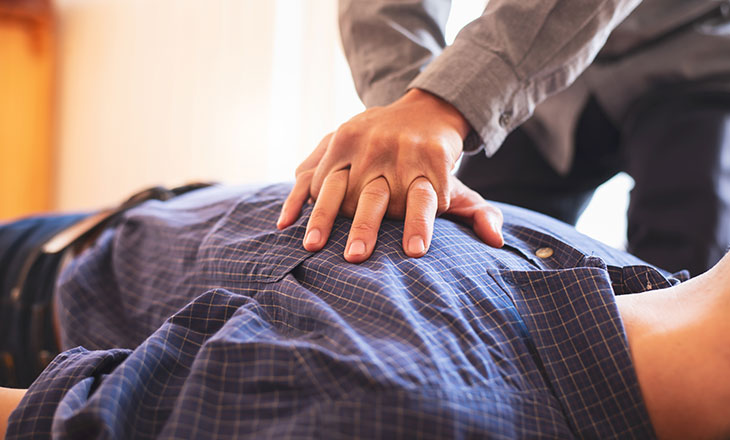
Sudden cardiac arrest, which is different than a heart attack, is a rare but serious event. It happens when the heart stops beating and is no longer able to send blood to the rest of the body. Sudden cardiac arrests can happen to anyone, regardless of age, fitness level or heart issues.
There are several causes of sudden cardiac arrest, including, very rarely, a sudden blow to the body.
In these cases, it’s critical to perform cardiopulmonary resuscitation (CPR) and use an automated external defibrillator (AED) as soon as possible.
Learn more about cardiac arrest
Why is it important to know CPR and how to use an AED?
It’s estimated that 350,000 Americans (adults and children) die from sudden cardiac arrest each year. Nearly 70% of cardiac arrests happen outside of the hospital, and about 90% of those people will die. Evidence suggests that over 6,000 children die outside of the hospital from a sudden cardiac arrest each year.
Some good news is that that when someone has a sudden cardiac arrest and a bystander initiates CPR quickly, about 45% of them can survive.
Knowing CPR and how to use an AED isn’t just for adults. It’s important to teach children and teens that they also can save a life. Studies have shown that kids as young as 9 can learn CPR. More than 30 states require CPR training for a high school graduation.
You don’t necessarily have to take a class every year, although it would be helpful to take at least one class in your lifetime. Watching a video each year to remind you how to do it is also very helpful.
As a parent, you should ask the caregivers in your child’s life if they are CPR certified. This could include a babysitter or sports coach. You never know when they may need to help your child in this situation.
Learn about Call-Push-Shock, a national movement by the Sudden Cardiac Arrest Foundation
How to save a life: CPR and AED use (UC Davis Health’s Kids Considered podcast)
Do sudden cardiac arrests only happen in adults?
No. Sudden cardiac arrest is the leading cause of death on school campuses and a leading cause of death in student athletes. Sudden cardiac arrests in young athletes occurs in about 1 in 70 schools per year.
What are some causes of sudden cardiac arrest?
Sudden cardiac arrests can be caused by an electrical abnormality of the heart. Or it can happen because the heart muscle is too large, too stiff, or unable to get enough oxygen supply. Some of these can be detected in a pediatrician’s office or during a yearly sports physical.
People can also suffer a sudden cardiac arrest by taking a forceful hit to the chest, such as during a tackle in a football game or from an incoming baseball.
Certain drugs or medications can also cause sudden cardiac arrest.
Learn about our heart and vascular care
What is the difference between a heart attacks and a sudden cardiac arrest?
A sudden cardiac arrest involves the electrical function of the heart. It’s when the heart suddenly stops beating. A heart attack is a circulation problem when blood flow to the heart is suddenly blocked.
What are the steps to perform CPR?
If you’re at a sporting event or see someone collapse while out for a walk, you may need to step in to help. Here are the steps you should follow to perform CPR:
- Check if the person is responsive: Make sure the area is safe and the person didn’t briefly pass out. Tap the person on the shoulder and shout, “Are you ok?” If they don’t respond, continue with these steps.
- Assign duties: If there are other people around you, assign someone specifically to call 911 and another to get an AED. Because these situations can feel crowded and chaotic, make eye contact, or say that person’s name to assign tasks. If there is no one around you, dial 911 and put your phone on speaker. Begin the CPR steps right away while you’re communicating with the first responder on the phone.
- Assess whether to start CPR or get an AED: If it’s a child, you’ll start CPR right away without searching for an AED. That’s because it’s more likely an airway issue – you don’t need to take the time to get the AED. If you’re helping an adult, you’ll want to get the AED right away because it’s likely a heart issue.
- Check for breathing: Make sure the person is on their back on a firm surface. Tilt the head back slightly to open the airway and listen for breathing. If you don’t hear or see breathing, you can begin CPR. You don’t need to check for a pulse.
- Start chest compressions: When you start CPR, place your hands one on top of the other interlocking fingers in the middle of the chest on the sternum, just above the nipple line. Keep your arms straight and use your body weight to help compress the chest. For adults (and adult-size kids), compress the chest at least 2 inches deep and at least 1/3 of the chest depth for younger children. Those compressions should be delivered at 100-120 compressions per minute. You can hum the song “Staying Alive” to help keep time or count out loud.
- Allow the heart to fill with blood: Push hard and fast, remembering that you need to compress the heart to continue the blood flow to their vital organs. You also need to ensure that the heart can fill with blood by letting the heart recoil. A trick to allow for full recoil is to let your palms lift off the chest slightly after each compression.
- Keep giving compressions/rescue breaths until help arrives: If you’re doing compressions only, doing so continuously until the paramedics arrive or the AED gets there. If you’re performing a combination of rescue breaths and compressions, you should give 30 compressions followed by two rescue breaths. This can be done by tilting the head back, pinching the nose, and breathing into the mouth. You should be able to see the chest rise with each breath and then immediately continue compressions.
- Use an AED: As soon as the AED arrives, follow the steps on the machine.
- Continue until paramedics arrive: Continue alternating between AED and CPR until the paramedics arrive or the person regains consciousness. If there is more than one person who knows CPR, you may want to switch out every two minutes. It can be tiring.
- Leave the AED turned on: If the person regains consciousness, leave the AED on, and turn them on their side.
Learn CPR or take a class with the American Red Cross
Get more CPR facts, statistics, and information to take a class
How do I use an AED?
An AED is used to analyze the rhythm of the heart. It’s a machine that can recommend delivering a shock to potentially reverse a life-threating arrhythmia, or abnormal heart rhythm. You may see these in many public places, like airports, sports stadiums, and schools.
A shock delivered by an AED within 3-5 minutes can save a life. After 5 minutes, survival rates decrease by 10% with each minute of delay.
- Once you have an AED, turn it on.
- Remove the person’s clothing covering their chest. If they are wet, you’ll need to dry them off to attach the pads.
- Place one pad on the upper right chest and one on the lower left chest. In smaller children, one can be placed on the front of the chest and the other on the back of the chest. If pediatric pads are available, you can use these in kids less than 8 years old. If they’re not available, adult pads can be used as well. This is all detailed in the AED kit.
- Allow the AED to analyze the heart rhythm. The machine will tell you if a shock is advised.
- If a shock is advised, you want to make sure everyone is clear of the person and not touching them. Then push the shock button on the AED.
- Resume CPR immediately. Keep the pads attached to the person and the AED machine turned on. It will reassess the heart rhythm every two minutes – you don’t have to do anything specific. It will keep time.
- The AED may recommend an additional shock or more than one shock. The AED is programmed and will walk you through what to do.
- Continue doing this until paramedics arrive.
- If the person regains consciousness, leave the AED on, and turn them on their side.
Learn more about how to use an AED
Project ADAM: How it prepares schools for sudden cardiac arrest
Project ADAM (Automated Defibrillators in Adam's Memory) was started in 1999 after a series of sudden deaths among high school athletes in Wisconsin. One of those athletes, 17-year-old Adam Lemel, died of sudden cardiac arrest while playing basketball. Adam’s family and friends joined together with Children's Wisconsin to start Project ADAM in his memory.
Since then, the program has expanded to 20 states with 25 affiliate programs at medical centers across the country, which has led to more than 150 lives saved on school campuses.
Project ADAM empowers schools and communities to be prepared for sudden cardiac arrest. Its mission is to help schools nationwide start and maintain a public access defibrillator (PAD) program. It provides the foundation for schools to develop a plan for using an AED in an emergency by providing resources, education, and training.
Established at UC Davis Children's Hospital in 2015, Project ADAM Sacramento is the first California affiliate of Project ADAM.
Learn more about how Project ADAM can help your child’s school become a Heart Safe School




